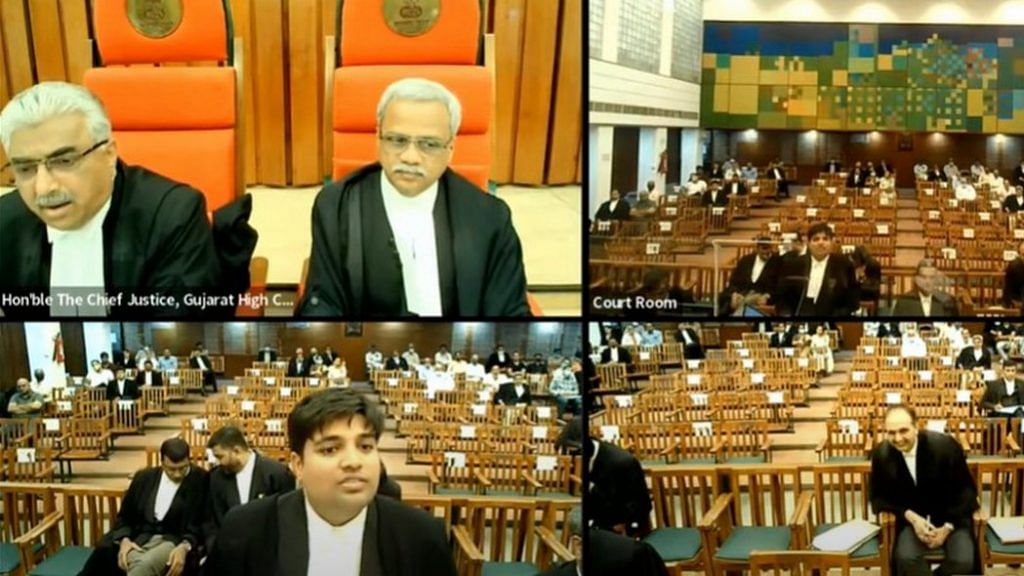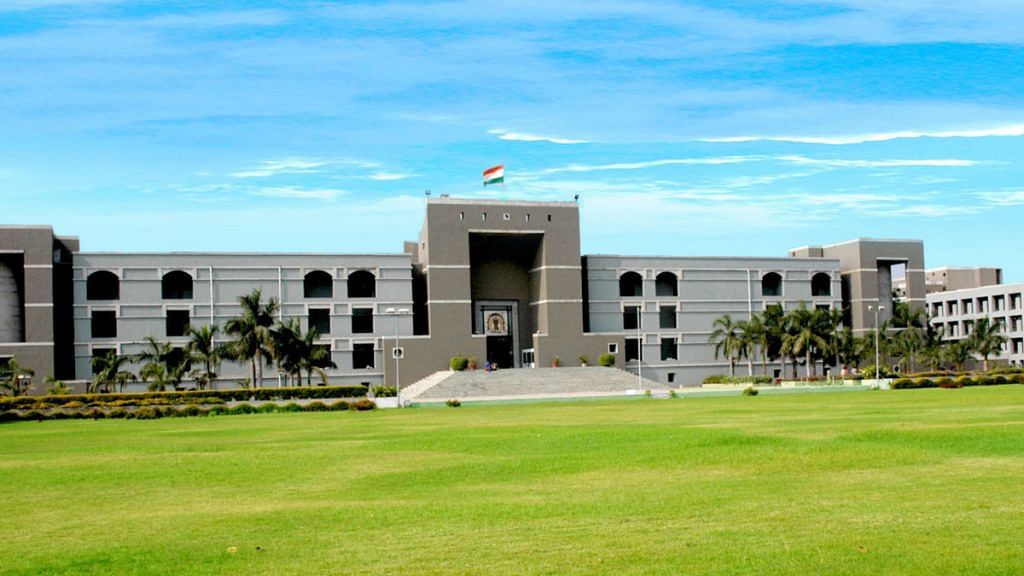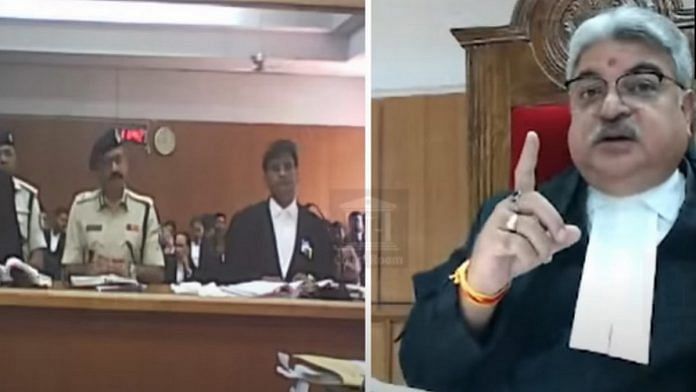New Delhi: Bombastic lawyers grab all the screen time in Indian legal dramas, but ever since courts started livestreaming their proceedings, judges have become the undoubted stars of the show. From their pithy commentary to their dialogue delivery to their humorous asides, viewers lap it all up, whether it’s an hour-long YouTube video or a snack-sized snippet on Insta.
When it comes to judges’ pronouncements, the fan favourites seem to be a toss-up between philosophical life advice and stern reprimands — at least going by the reactions in the comments sections.
“Love is lost. Emotions have dried up. Where is the love between them? Where is the affection?” observes Justice Rohit Arya of the Madhya Pradesh High Court in one divorce hearing, in which he also advises the sobbing wife to move on with her life and not view divorce as a kalank (stigma).
The 20-minute video was posted by one of the many YouTube court channels that have mushroomed lately, with the description lauding Arya for counselling the estranged couple like an “abhibhavak (parent)”.
Then there’s the famous video of Justice P.B. Bajanthri of the Patna High Court castigating an IAS officer for not wearing a coat. “Have you entered a cinema hall?” the judge snaps at the bewildered civil servant.
The video, titled ‘IAS warned for his dress by Patna High Court Judge’, was uploaded on YouTube on 22 May, and has over 10 lakh views.
In another video, Chief Justice Aravind Kumar of the Gujarat High Court displays a range of emotions during a custody hearing. “You want custody of the children? First pay money… [it] will be subject to the payment of rokda,” he tells the father’s lawyer, who smiles nervously. The judge later adopts a gentler tone.
“Every child has to have his childhood… Both of you, don’t fight in the presence of your children, it will have a negative impact on their development,” Kumar says. Most of the dozens of comments on the video are full of praise. “We need this lordship in every corner of the whole world,” says one.

The Supreme Court of India made national headlines when it finally livestreamed three proceedings last month. By 5pm on 27 September, more than 7 lakh viewers had logged on to the National Informatics Centre’s (NIC’s) YouTube webcast to watch the hearings.
However, it’s the high courts of the country that have whetted the appetite of audiences.
At least eight high courts have their own YouTube channels to livestream proceedings, with the Gujarat High Court leading the way two years ago, in October 2020.
Since then, it has become evident that people are interested in watching court proceedings, especially if they involve public interest cases. For instance, the Karnataka High Court’s hearings of the controversial hijab ban case are the most viewed on its YouTube channel. Two of them have over 7 lakh views (see here and here) and another one has over 4 lakh views.
Overall, high court livestreams and recordings haven’t just contributed to making the judicial system more transparent, but have also seen strong viewership across platforms — YouTube, Instagram, and Facebook. They’ve also turned some judges into bona fide celebrities.
Also read: Over 7 lakh watch as SC starts live-streaming hearings. ‘Real’ Sena tussle rakes in most views
‘Real hero’
With his shock of salt-and-pepper hair and acerbic style, the MP High Court’s Rohit Arya is one of the most popular judges on viewing platforms. Some videos featuring him have racked up over 10 lakh views, including one in which he challenges a lawyer for demanding bail for a client on the ground that his wife is soon to deliver a baby.
“Kitni baar biwi ki delivery karwaoge? (How many times will you make his wife deliver a baby)?” Arya asks in the video, pointing out that the same reason had been offered to justify bail earlier too.
In another video with over 10 lakh views, he is in fiery form, pulling up a cop and thundering “Shut up!” at one point.
The comments on many court videos have viewers celebrating the wisdom and authority of judges and how they interact with lawyers and witnesses. Others speak of their “hope” in the system returning.
The responses are effusive in one clip that shows Arya commanding a station house officer to find a missing child within 15 days or else it could endanger his job. “’You are making poor ones plea heard and get justice on time. People like you makes us believe in system sir (sic),” says a viewer.
On a Facebook reel showing Arya scolding police officers in relation to the probe in a rape and murder case (“Don’t cross your limits!”), the comments cheer him on. “Real hero we proud of you my lord (sic),” declares one.
In a 5 June video from the Patna High Court, Justice Ashutosh Kumar rebukes a lawyer for his “half-baked preparation” in a bail application, but nevertheless grants it.
“Still granted the bail… the judge knows that the accused shouldn’t suffer on behalf of the incompetent lawyer (sic),” one of the comments says.

The first video uploaded by the Gujarat High Court has over 12 lakh views and over 1,000 comments. Most of these comments flow from the general public, appreciating the beauty of court craft, and the high court’s initiative. Several viewers also mention how they are viewing real court proceedings for the first time and comparing it with court proceedings in movies.
For instance, one viewer gushes: “I never knew that even judges also argue with lawyers. Movies taught me wrong.”
Another comment says: “By watching this, I got to know that what ever I saw the court scenes in some movies are very far from reality. How judges are very fast and quickly reading the petitions, that’s really great.(sic)”
‘Sunlight is the best disinfectant’
The Supreme Court had authorised livestreaming of court proceedings four years ago, back in 2018, in the Swapnil Tripathi judgment.
In this judgment, Justice D.Y. Chandrachud had famously remarked that “sunlight is the best disinfectant”. He now heads the e-committee of the Supreme Court.
However, the first such initiative only came in October 2020, when the Gujarat High Court became the first in the country to livestream its hearings. Its YouTube channel now has over 1.5 crore views on its videos, and the channel has 1.11 lakh subscribers.
In June last year, the Supreme Court e-committee, headed by Justice Chandrachud, released draft model rules for livestreaming and recording of court proceedings, inviting suggestions and inputs from all stakeholders.
On 26 August, the Supreme Court livestreamed its proceedings for the first time. The proceedings of the ceremonial bench of Chief Justice of India N.V. Ramana were livestreamed on his last day in office.
Dedicated YouTube channels
The livestreaming of high court proceedings has also led to a parallel booming of YouTube channels dedicated to showcasing clippings of exchanges between judges and lawyers.
One such channel called Law Chakra began uploading videos only five months ago, but already has 74.8k subscribers. The channel has over 140 videos, and almost all of them are snippets of court hearings or judges’ speeches.
Another channel, Court Room, was launched on 30 June this year, and has already managed to get 126k subscribers, with over 170 videos of court hearings. The channel’s description says it is trying to promote the efforts of the courts to make themselves transparent to the people.
Another similar-sounding channel is Court Room Live. It began on 30 June, with the intention to “educate legal interns and [the] common Indian public about legal proceedings through actual courtroom live videos”. Clips of hearings have also made it to several meme pages on Instagram, and to other YouTube channels focussed on imparting legal education.
‘Might put judges on guard’
Legal professionals don’t always agree on the benefits of courtroom livestreaming. While some are strong votaries, others believe there is a flip side.
According to senior advocate K.T.S. Tulsi, livestreaming “brings justice closer to the people” and puts the “truth” on the screen.
“Whether it is palatable or unpalatable, truth cannot do harm to anyone. I think it should’ve been done much earlier,” he said.
As far as Tulsi is concerned, there are no downsides to livestreaming. In fact, he said, “some of the whimsical things will be avoided” on the part of judges.
On the other hand, senior advocate Geeta Luthra has a few reservations, although she too believes that livestreaming will help “bring transparency and strengthen accountability in the Indian judiciary”.
“It is indeed true that livestreaming of court proceedings which are not sensitive in nature would be much appreciated in India. However, our media must also realise its responsibility while reporting on the cases, and exercise its restraint,” she said.
According to Luthra, livestreaming could also potentially have an adverse impact “on the overall dispensation of justice administration”.
She explained: “For instance, there may at times be a light-hearted exchange between the bar and the bench, which we may not necessarily want to be made a matter of record, or worse, get misreported. In fact, very recently, Justice D.Y. Chandrachud remarked that every statement which is orally made by the Supreme Court judges, in the course of hearing a matter, is not an order.”
In view of this, she said it is important to ensure that “while we have transparency and accountability in our justice system, there is no extraneous pressure on the bar and bench”.
(Edited by Asavari Singh)
Also read: 1 mn backlog, 37% vacancies, but Allahabad HC lawyers don’t want ‘outsiders’ to fill judges’ ranks



